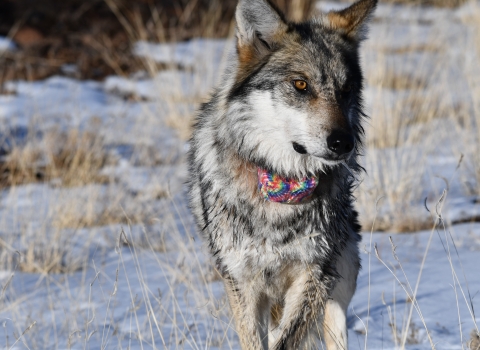For the first time since reintroduction into the wild, the population of Mexican wolves in Arizona and New Mexico has surpassed 200 with a minimum of 241 wild wolves documented in 2022.
“This milestone has been 25 years in the making,” said Brady McGee, U.S. Fish and Wildlife Service Mexican Wolf Recovery Coordinator. “To go from zero wild Mexican wolves at the start to 241 today is truly remarkable. In 2022, we recorded more packs, more breeding pairs, and a growing occupied range, proving we are on the path to recovery. These achievements are a testament to partner-driven conservation in the west.”
The 2022 population estimate represents a 23 percent increase from the minimum of 196 wolves in 2021. This marks the seventh consecutive year of population growth and a more than doubling in size since 2017. The population is distributed with 136 wolves in New Mexico and 105 in Arizona.
“The road to recovery for any endangered species is neither straight or easy, and this has proven to be the case for the Mexican wolf,” said Jim deVos, Arizona Game and Fish Department Mexican Wolf Coordinator. “With the stunning growth that occurred in 2022, recovery has accelerated at an amazing rate. By every possible measure, progress was made, including the production from 31 breeding pairs that produced 121 pups, of which 81 were documented to having survived to the time of the count, which is a very high survival rate of 67 percent. While the road to recovery still has ground to be covered, in 2022, the recovery program covered a lot of ground.”
Mexican wolf population information is gathered from November through February by the Interagency Field Team (IFT). During this time, the IFT conducts ground and aerial surveys, using a variety of methods, including remote cameras, scat collection, and visual observation. Counting the population at the end of each year allows for comparable year-to-year trends at a time of year when the Mexican wolf population is most stable.
Among the 2022 findings:
- A minimum of 59 packs were documented at the end of 2022: 40 in New Mexico and 19 in Arizona. A wolf pack is defined as two or more wolves that maintain an established home range.
- A minimum of 121 pups were born in 2022, with at least 81 surviving until the end of the year (a 67 percent survival rate). The average survival of Mexican wolf pups in their first year is around 50 percent.
- A minimum of 31 breeding pairs (20 in New Mexico, 11 in Arizona) was recorded in 2022. A breeding pair is defined as a pack that consists of an adult male and female and at least one pup of the year surviving through December 31.
- There were 109 collared wolves in the wild at the end of the year, which is 45 percent of the wild population.
“Continued cooperation among the state wildlife agencies of Arizona and New Mexico and the Service is essential for recovery of the Mexican wolf,” said Stewart Liley, Chief of Wildlife, New Mexico Department of Game and Fish. “During this count and capture effort, we were able to capture and radio collar 21 wolves, which will provide a better understanding of wolf activity and help with on the ground wolf management. As we work toward achieving recovery goals, we continue working to build a strong, cooperative team to manage wolves across the range.”
Additional highlights from the year include:
- Pup fostering efforts resulted in 11 pups from captivity being placed into five wild dens in the spring. The IFT has since documented survival of 2 of these pups. This brings the known number of fostered wolves documented alive to 14.
- The IFT documented the lowest annual total Mexican wolf mortalities since 2017 (when the population was significantly smaller). There were 12 documented mortalities, 6 in Arizona and 6 in New Mexico, in 2022. This is substantially lower than 2021 (25 mortalities) and 2020 (29 mortalities).
- The U.S. Fish and Wildlife Service successfully rescued seven captive Mexican wolves from enclosures at the Ladder Ranch Wolf Management Facility during the Black Fire in the spring. The wolves were temporarily held at the Sevilleta Wolf Management Facility until it was safe to return them to the Ladder Ranch.
- The U.S. Fish and Wildlife Service, Arizona Game and Fish Department, New Mexico Department of Game and Fish, and the Ministry of Environment and Natural Resources through its National Commission for Natural Protected Areas and the Directorate General for Wildlife, signed a Letter of Intent establishing the intentions of all parties to collaboratively continue to conserve, manage, and recover the Mexican wolf in the U.S. and Mexico.
- Sierra County, New Mexico became a Signatory Cooperating Entity under the Memorandum of Understanding for Mexican Wolf Recovery and Management. This brings the total number of MOU signatories to 17.
The Mexican wolf is the rarest subspecies of gray wolf in North America. It is listed separately from the gray wolf as an endangered subspecies under the federal Endangered Species Act. In 1977, the Service and its partners-initiated efforts to conserve the subspecies by developing a bi-national captive breeding program with the seven remaining Mexican wolves in existence. Mexican wolves were first reintroduced to the wild in 1998, marking the first time in 30 years Mexican wolves were known to exist in the wild in the United States.
In addition to the minimum wild population, there are approximately 380 Mexican wolves currently maintained in more than 60 facilities throughout the United States and Mexico through the Mexican Wolf Species Survival Plan.
Partners in Mexican wolf recovery in the United States include the Service, Arizona Game and Fish Department, New Mexico Department of Game and Fish, U.S. Department of Agriculture (USDA) Forest Service, USDA APHIS Wildlife Services, White Mountain Apache Tribe, Bureau of Land Management, National Park Service, and the Species Survival Plan.




